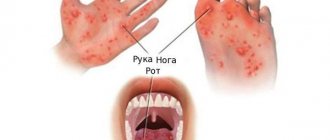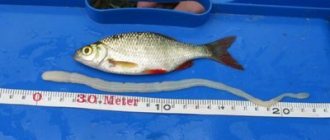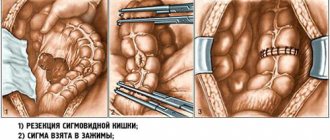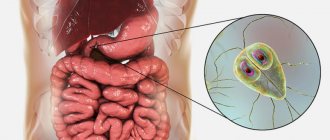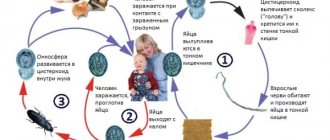Worms are considered one of the most common types of parasitic worms that infect humans. Characterized by a wide variety of species and forms, helminths can provoke the development of many serious diseases.
A helminthic infestation is quite easy to detect due to the huge number of external manifestations of infection. On the other hand, the majority of symptoms caused by helminths are not specific, which, along with the high number of parasites in the body, can greatly complicate making a specific diagnosis. As a rule, the final differentiation of the disease occurs only based on the results of a special laboratory study. What are the signs of helminthic infestation in adults?
About roundworm infection
Roundworms cause a whole group of diseases.
Nematodes are a whole group of specific diseases caused by the same pathogen - roundworms.
Symptoms of such ailments can be very different, depending on the type of parasite that has entered the body. In general, all nematodes can be divided into two large categories:
- acute, characterized by a clear manifestation of symptoms from the very first days of the development of the disease;
- chronic, sluggish and passing, as a rule, almost asymptomatic.
Molecular Biology Research
In more complex diagnostic cases, genetic tests from the field of molecular biology can be performed. Indications for such tests:
- suspicion of low intensity infection (cannot be detected using basic tests);
- localization of the parasite;
- difficult to reach organically (sampling may be an invasive procedure);
- difficulties in differentiating species and the need to determine drug sensitivity.
These tests also complement imaging tests (ultrasound) and negative stool microscopic examination results. The material may be blood, feces, or other tissue from the injured person.
Molecular studies use the following methods: PCR (polymerase chain reaction), real-time PCR, nested PCR, loop isothermal amplification method (LAMP) and fluorescence in situ hybridization (FISH).
Roundworms
The most common causative agent of nematodes in humans is roundworm. Typically, the first signs of infection with this worm appear in the second week, when the larvae of the parasite begin the migratory phase.
Most patients suffering from one type or another of ascariasis exhibit the same characteristic symptoms of this condition. Thus, with helminthic infestation of the lungs, patients usually complain of:
- temperature increase;
- paroxysmal asthmatic cough accompanied by chest pain;
- discharge from the lungs of a small amount of mucous sputum (sometimes streaked with blood).
Due to the ambiguity of symptoms, the described type of ascariasis is often confused with allergies, bronchitis, ARVI, asthma or even pneumonia. This kind of invasion is generally the last thing to be suspected, since the adult parasite does not take root in human lungs.
In other words, such a condition can arise only during the period of migration of roundworm larvae. As a result, only an x-ray showing a large number of infiltrates (that is, accumulations of eosinophils reacting to helminth toxins) in the patient’s lungs usually helps to establish an accurate diagnosis. With helminthic infestation of the intestines, the symptoms of the disease become more specific:
How to identify dangerous parasites
It is impossible to identify and treat dangerous residents on your own, especially since they can exist in a complex and by eliminating some, you will only make room for others. Every clinic has a parasitologist; he is the one who treats infestations. If there is no such specialist, you can make an appointment with a therapist.
The doctor will prescribe a number of tests:
- Blood for clinical analysis. With helminthiases, an acceleration of ESR, a decrease in hemoglobin and an increase in the number of eosinophils are observed.
- Biochemical blood test for ALT, AST, alkaline phosphatase, thymol test, amylase. An increase in these indicators is typical for infection with nematodes.
- Analysis of bile, mucus, sputum, muscle tissue.
Worm infestations are often disguised as other diseases. People undergo operations during which they find a eaten away pancreas or liver. It is not always possible to cure a patient with an advanced form, so you should not hope for a miracle - you need to take the same test for “worm eggs” in a timely manner. To make a diagnosis, endoscopy of the intestines and stomach is prescribed.
Diseases caused by parasitic protozoa are difficult to detect. The infection proceeds latently and destroys the body until the patient exhibits serious organ changes.
Pinworms
Pinworms - cause severe swelling in the anus.
In general, pinworm infection is characterized by the same specific symptoms as ascariasis. In addition, the patient may feel severe itching in the anus, noticeably increasing in the evening and at night.
The nervous system suffers especially greatly with this type of helminthic infestation: the patient becomes restless and irritable; suffers from sleep disorders.
Typically, all the described symptoms begin to appear at the moment when the parasite that has settled in the body fully matures and begins the active process of reproduction and laying eggs.
Young children are most often infected with pinworms. The disease caused by these parasites, enterobiasis, in some cases can manifest itself in the form of urinary incontinence or suspicious heavy vaginal discharge (in women) or a rash similar to hives that occurs in the genital area (in both sexes). This is due to the fact that, in attempts to lay eggs in the perianal area, worms can penetrate the urethra.
It is curious that pinworms never begin to reproduce directly in the intestines. That is why the fact of infection with these helminths is so difficult to establish using a standard stool analysis, while eggs or even adult individuals of other parasites can often be seen in the stool with the naked eye.
How to become infected with helminths: raw water, exotic cuisine and unwashed hands
You should not think that parasites live only in people who do not take care of themselves and lead an asocial lifestyle. Anyone can become infected, because a person is not immune from communicating with sick people and “parasite carriers”. Uninvited “guests” enter the body through food, water from pets, through dirty hands and insect bites.
Infection is encouraged by people buying homemade lard, raw meat, dried and smoked fish at unauthorized markets. You can become infected in a canteen or cafe if sanitary conditions are not met there. Undercooked meat and fish dishes are dangerous.
The parasites have also benefited from the passion for Japanese cuisine, where thermally unprocessed fish is added to dishes. Not all sushi bar chefs follow sanitation rules. As a result, a person becomes infected with helminths.
Trichinella
Trichinella disrupts heart rhythm.
Trichinosis, or infection of the body with roundworms - Trichinella, usually occurs in three phases:
- an asymptomatic incubation period, which usually lasts no more than one and a half months;
- phase of disease development, accompanied by characteristic clinical symptoms (fever, chills, general weakness, muscle pain and swelling);
- peak of the disease, characterized by persistent fever, myalgia of the muscles of the neck, calves and lower back, puffiness of the face and allergic skin rashes (the latter appear as a result of an allergic reaction to helminths, accompanied by an increase in the level of eosinophils in the blood).
If trichinosis reaches its peak stage, the active development of accompanying respiratory tract diseases, such as bronchitis, pleurisy or even pneumonia, begins. The cardiovascular system suffers no less.
Thus, for carriers of Trichinella, heart rhythm disturbances, tachycardia and arterial hypertension are very typical. As is the case with damage to the body by other helminths, prolonged presence of parasites in the body of the carrier can ultimately lead to appendicitis and peritonitis, anaphylactic shock, internal bleeding, the initiation of oncological processes, or even brain damage.
Why ultrasound is more effective than traditional examinations for worms and other parasites
Giving stool or scraping does not always reveal worms. The fact is that parasites have a certain development cycle and do not always lay eggs. There is a whole group of extraintestinal helminthiases, in which worms live outside the intestines. In this case, a stool test will not provide any information.
Ultrasound of the abdominal cavity shows changes characteristic of the presence of parasites in the liver and pancreas. It is harmless, non-traumatic and can be used many times.
If the doctor does not detect live helminths and 100% signs of their presence on the ultrasound, he will suspect infection and prescribe an additional examination. It is also useful to undergo an ultrasound if tests for worms are positive. The study will show where the parasites are hiding.
Wide tapeworm
In severe cases of tapeworm infection, high fever and nausea occur.
Another dangerous flat parasite for humans, the broad tapeworm, causes a rather specific type of helminthiasis. We are talking about a disease called diphyllobothriasis.
This helminthiasis is distinguished by the long incubation period of its pathogen (it takes, on average, about two months for the worm to “take root” in the body). How is diphyllobothriasis diagnosed?
As a rule, the general condition of the patient with helminthiasis of this type is only slightly impaired. In some cases, the infected person may complain of slight dizziness or malaise, which appears only occasionally.
With a more severe form of infection that occurs with complications, the symptoms of diphyllobothriasis become more pronounced. The patient experiences an increase in body temperature (usually up to 37.5 degrees), nausea and diarrhea. Unpleasant, crusty rashes appear on the skin.
Most patients also complain of pain in the upper abdomen.
The easiest way to diagnose diphyllobothriasis is by assessing the condition of the patient’s oral cavity. Thus, when infected with a wide tapeworm, the mucous membrane of the host’s mouth becomes covered with bright red painful spots. A similar picture is observed in the tongue, where, in addition, atrophy of the taste buds can be noticed.
Signs of helminthiasis determined by ultrasound of the abdominal cavity - half-living organs and live worms
When examining the gastrointestinal tract using modern 3D and 4D devices, doctors often see live parasites in the intestines. If helminths are not detected, their presence can be suspected by an enlarged pancreas, compacted in the head area. The spleen is also too large.
The liver is enlarged due to parasitic infection by flukes, trematodes and flukes. It reveals areas of dystrophy that impede the functioning of the organ.
The gallbladder also suffers. Patients experience stagnation of bile, causing pain in the right hypochondrium. Sometimes the function of the bladder is so impaired that the organ cannot be identified on ultrasound at all.
The presence of parasites leads to the formation of abscesses - purulent liver lesions that are life-threatening. In 85% of cases, abscesses form in one lobe of the liver. Other departments suffer less frequently. Purulent lesions are characteristic of hepatic amebiasis - infection with a protozoan - an amoeba that penetrates the liver region from the intestine.
Significant changes in the liver are observed during echinococcosis, a parasitic disease in which cavities filled with helminth larvae form inside the organ. Ultrasound shows round formations with clear boundaries. These are cysts that contain parasites. Over time, calcium is deposited around echinococcal lesions. Such formations have a dense structure, so on ultrasound they look lighter than the surrounding tissues.
With prolonged infection, large cysts with partitions are formed, resembling wheel spokes or large honeycombs. Destruction of the bile ducts is observed. Doppler examination reveals a disturbance in blood flow.
Prevention of helminthiasis
It is important to undergo examination when the first symptoms of helminthic infestation appear. Parasites are extremely dangerous to human health. Can lead to the development of serious diseases. Children experience growth retardation and the absorption of nutrients is disrupted. Infection during pregnancy increases the manifestation of toxicosis. There is a risk of the parasite penetrating the placenta. It can damage the fetus and cause miscarriage.
You can protect yourself by following simple hygiene standards. Wash your hands, vegetables, and fruits thoroughly. Follow the rules of food preparation, exclude from the diet meat and fish that have not passed sanitary control. Drink only purified water, not directly from natural sources. Latrine areas must be equipped with disinfection systems so as not to contaminate the soil. Pets must undergo veterinary control regularly.
Treatment
It is impossible to get rid of the infection without drug treatment, so the basis of therapy is always taking medications. If the patient's condition is severe, hospitalization and constant monitoring by the attending physician may be required. Folk remedies will be effective only as an addition to drug therapy.
It may take several years to completely remove parasites from the body, it all depends on their type and the timeliness of seeking medical attention.
Medication
Previously, choosing a medicine was not easy, since most antiparasitic drugs had a narrow spectrum of action, that is, they were effective in the fight against a certain type of helminth. Today there are remedies used for any helminthic infestations.
Most antiparasitic drugs are contraindicated during pregnancy and lactation. For women in such conditions, therapy is selected strictly by a doctor; herbal remedies are often prescribed.
The following drugs are considered the most effective:
- Albendazole - there are also several drugs in which albendazole is an active ingredient: Nemozol, Gelmodol, others. The products are available in the form of tablets and suspensions.
- Mebendazole - there are also several drugs in which mebendazole is an active ingredient: Vormin, Vermox. It affects the metabolic processes inside the parasites, disrupts them, which causes the death of the pests.
- Levamisole or Decaris. Often used either for prevention or for minor infections. The package contains 1 tablet of the drug, it is taken before bedtime. If nausea, vomiting, and other signs of intoxication appear in the morning, this means that more serious antiparasitic therapy is required.
And also general strengthening, painkillers, and other groups of drugs can be prescribed, but the prescription is strictly made by the attending physician individually.




